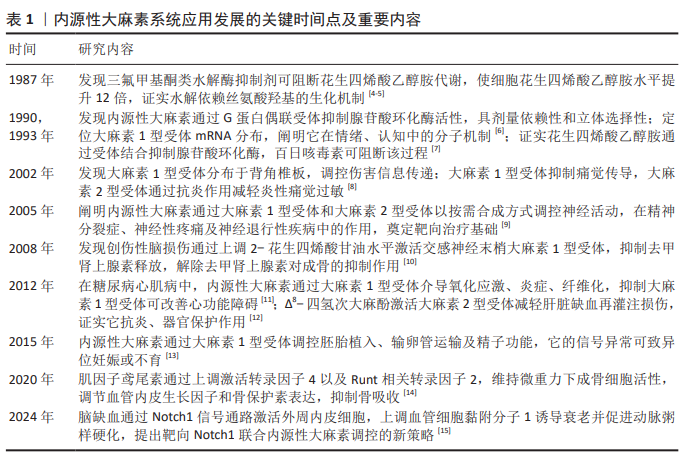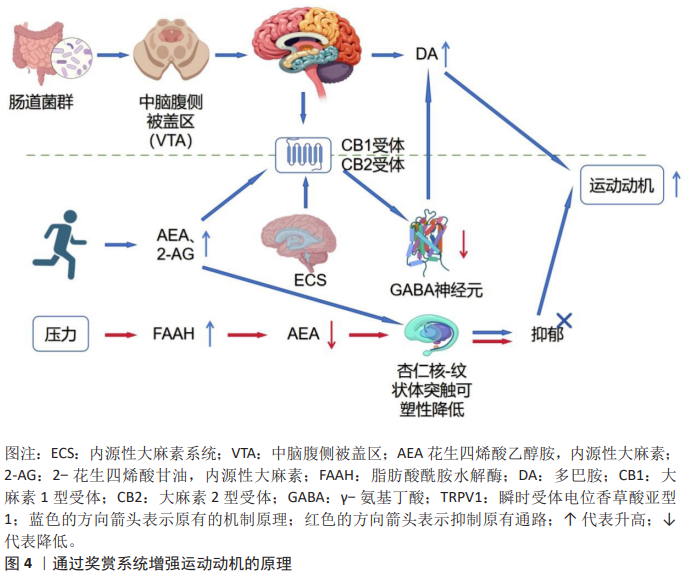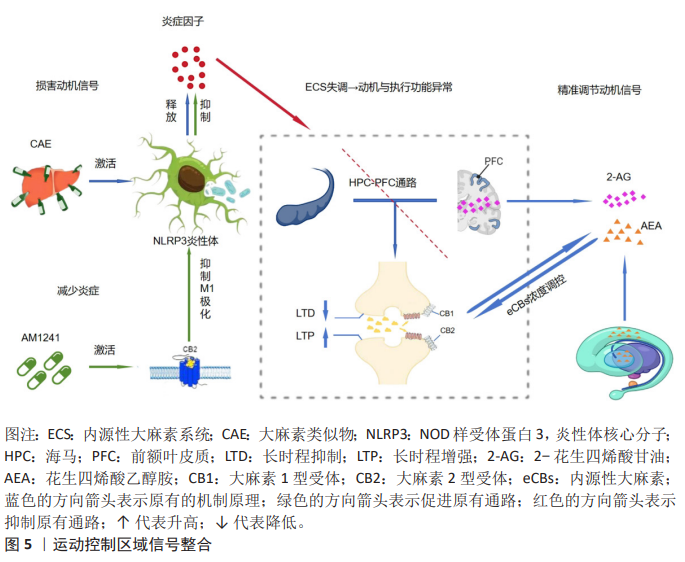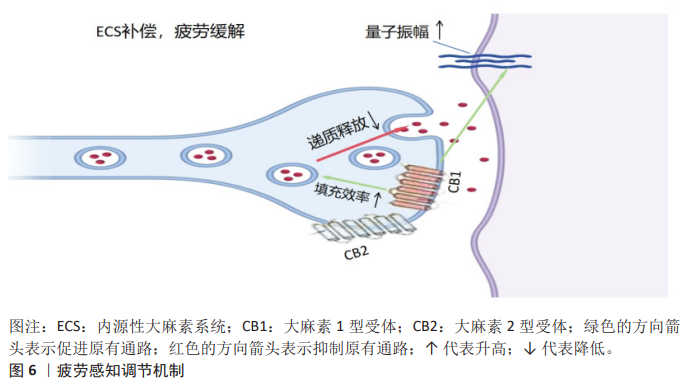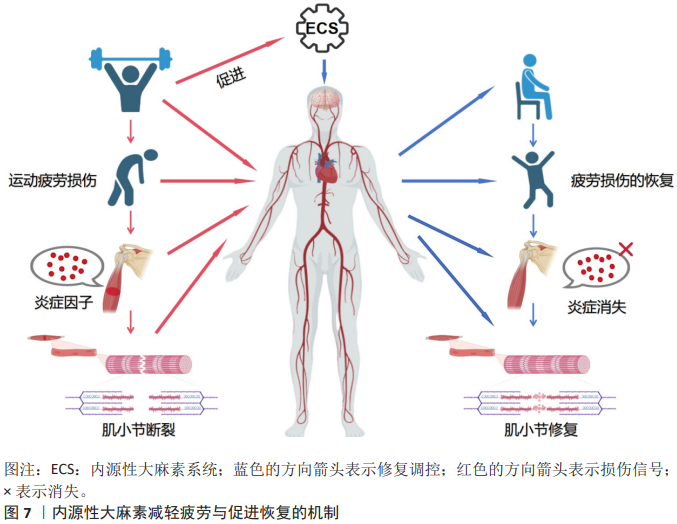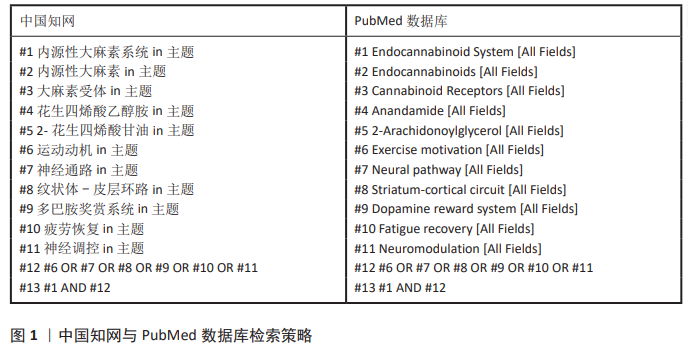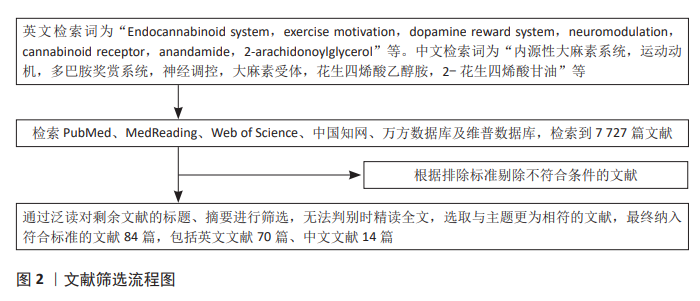[1] 洪金涛,陈思同,刘阳.《身体活动汇编》(Compendium of Physical Activities):内容、应用与发展[J].上海体育学院学报,2020,44(9):53-63.
[2] LOWE H, TOYANG N, STEELE B, et al. The Endocannabinoid System: A Potential Target for the Treatment of Various Diseases. Int J Mol Sci. 2021;22(17):9472.
[3] MATEI D, TROFIN D, IORDAN DA, et al. The Endocannabinoid System and Physical Exercise. Int J Mol Sci. 2023;24(3):1989.
[4] Koutek B, Prestwich GD, Howlett AC, et al. Inhibitors of arachidonoyl ethanolamide hydrolysis. J Biol Chem. 1994;269(37):22937-22940.
[5] KONRAD RJ, MAJOR CD, WOLF BA. Diacylglycerol hydrolysis to arachidonic acid is necessary for insulin secretion from isolated pancreatic islets: sequential actions of diacylglycerol and monoacylglycerol lipases. Biochemistry. 1994;33(45):13284-13294.
[6] MATSUDA LA, LOLAIT SJ, BROWNSTEIN MJ, et al. Structure of a cannabinoid receptor and functional expression of the cloned cDNA. Nature. 1990;346(6284):561-564.
[7] VOGEL Z, BARG J, LEVY R, et al. Anandamide, a brain endogenous compound, interacts specifically with cannabinoid receptors and inhibits adenylate cyclase. J Neurochem. 1993;61(1):352-355.
[8] RICE AS, FARQUHAR-SMITH WP, NAGY I. Endocannabinoids and pain: spinal and peripheral analgesia in inflammation and neuropathy. Prostaglandins Leukot Essent Fatty Acids. 2002;66(2-3):243-256.
[9] GAMBI F, DE BERARDIS D, SEPEDE G, et al. Cannabinoid receptors and their relationships with neuropsychiatric disorders. Int J Immunopathol Pharmacol. 2005;18(1):15-19.
[10] TAM J, TREMBOVLER V, DI MARZO V, et al. The cannabinoid CB1 receptor regulates bone formation by modulating adrenergic signaling. FASEB J. 2008;22(1):285-294.
[11] RAJESH M, BÁTKAI S, KECHRID M, et al. Cannabinoid 1 receptor promotes cardiac dysfunction, oxidative stress, inflammation, and fibrosis in diabetic cardiomyopathy. Diabetes. 2012;61(3):716-727.
[12] BÁTKAI S, MUKHOPADHYAY P, HORVÁTH B, et al. Δ8-Tetrahydrocannabivarin prevents hepatic ischaemia/reperfusion injury by decreasing oxidative stress and inflammatory responses through cannabinoid CB2 receptors. Br J Pharmacol. 2012;165(8):2450-2461.
[13] MACCARRONE M, BAB I, BÍRÓ T, et al. Endocannabinoid signaling at the periphery: 50 years after THC. Trends Pharmacol Sci. 2015;36(5):277-296.
[14] COLUCCI S, COLAIANNI G, BRUNETTI G, et al. Irisin prevents microgravity-induced impairment of osteoblast differentiation in vitro during the space flight CRS-14 mission. FASEB J. 2020;34(8):10096-10106.
[15] LIU M, WANG D, QI C, et al. Brain ischemia causes systemic Notch1 activity in endothelial cells to drive atherosclerosis. Immunity. 2024;57(9):2157-2172.e7.
[16] Dietrich A, McDaniel WF. Endocannabinoids and exercise. Br J Sports Med. 2004;38(5):536-541.
[17] GUZMAN M. Cannabinoids: Potential anticancer agents. Nat Rev Cancer. 2003;3(10):745-755.
[18] BOROWSKA M, CZARNYWOJTEK A, SAWICKA-GUTAJ N, et al. The effects of cannabinoids on the endocrine system. Endokrynol Pol. 2018;69(6):705-719.
[19] SRIVASTAVA RK, LUTZ B, RUIZ DE AZUA I. The Microbiome and Gut Endocannabinoid System in the Regulation of Stress Responses and Metabolism. Front Cell Neurosci. 2022;16:867267.
[20] WELLER K, REEH PW, SAUER SK. TRPV1, TRPA1, and CB1 in the isolated vagus nerve--axonal chemosensitivity and control of neuropeptide release. Neuropeptides. 2011;45(6):391-400.
[21] GORZALKA BB, HILL MN. Putative role of endocannabinoid signaling in the etiology of depression and actions of antidepressants. Prog Neuropsychopharmacol Biol Psychiatry. 2011;35(7):1575-1585.
[22] REZENDE B, ALENCAR AKN, DE BEM GF, et al. Endocannabinoid System: Chemical Characteristics and Biological Activity. Pharmaceuticals (Basel). 2023;16(2):148.
[23] ZAJKOWSKA ZE, ENGLUND A, ZUNSZAIN PA. Towards a personalized treatment in depression: endocannabinoids, inflammation and stress response. Pharmacogenomics. 2014;15(5):687-698.
[24] FILBEY FM, BEATON D, PRASHAD S. The contributions of the endocannabinoid system and stress on the neural processing of reward stimuli. Prog Neuropsychopharmacol Biol Psychiatry. 2021;106:110183.
[25] TURCO F, BRUGNATELLI V, ABALO R. Neuro-Gastro-Cannabinology: A Novel Paradigm for Regulating Mood and Digestive Health. Med Cannabis Cannabinoids. 2023;6(1):130-137.
[26] GROENEWEGEN HJ. The basal ganglia and motor control. Neural Plast. 2003;10(1-2):107-120.
[27] DOHNALOVÁ L, LUNDGREN P, CARTY JRE, et al. A microbiome-dependent gut-brain pathway regulates motivation for exercise. Nature. 2022;612(7941):739-747.
[28] 王其飞,杜兴彬,孔健达.中枢疲劳的神经生理基础及运动诱发机制[J].中国组织工程研究,2025,29(32):6979-6988.
[29] 牟连伟,葛未未,王海英,等.运动奖赏效应及其神经生物学机制的研究进展[J].生命科学,2023,35(3):360-366.
[30] 王海军,牛亚凯,陈巍.内源性大麻素系统在运动促进脑健康中的研究进展[J].生命科学,2021,33(09):1096-1103.
[31] STEEL RP, BISHOP NC, TAYLOR IM. The effect of autonomous and controlled motivation on self-control performance and the acute cortisol response. Psychophysiology. 2021;58(11):e13915.
[32] BOSTAN AC, STRICK PL. The basal ganglia and the cerebellum: nodes in an integrated network. Nat Rev Neurosci. 2018;19(6):338-350.
[33] BROMBERG-MARTIN ES, MATSUMOTO M, HIKOSAKA O. Dopamine in motivational control: rewarding, aversive, and alerting. Neuron. 2010;68(5):815-834.
[34] OTT T, NIEDER A. Dopamine and Cognitive Control in Prefrontal Cortex. Trends Cogn Sci. 2019;23(3):213-234.
[35] STUBER GD. Neurocircuits for motivation. Science. 2023;382(6669):394-398.
[36] 陈依琪,韩曼,邹佳,等.运动技能学习的小脑环路机制[J].生命科学,2023,35(2):157-164.
[37] 魏龙威,王寅昊,杨子铮,等.伏隔核多巴胺受体与MSNs调控运动动机的神经机制[J].体育科学,2024,44(12):58-69.
[38] 蔡厚德,刘昌.大脑前扣带回皮层与执行功能[J].心理科学进展,2004,12(5):643-650.
[39] WONG R, SESA-ASHTON G, DATTA S, et al.
The role of the dorsolateral prefrontal cortex in control of skin sympathetic nerve activity in humans. Cereb Cortex. 2023;33(13):8265-8272.
[40] 曹娜,孟海江,王艳秋,等.左侧背外侧前额叶在程序性运动学习中的作用[J].心理学报,2020,52(5):597-608.
[41] 黄嘉雯,叶懂焕,庄中天,等.冷环境、运动与限食通过ghrelin/Goat/GHS-R系统调节能量平衡的研究进展[J].生命科学,2022,34(12):1540-1549.
[42] 马震武,朱浩,王晓东.下丘脑神经干细胞调控能量平衡与肥胖的研究进展[J].南京医科大学学报(自然科学版),2024,44(5):738-742.
[43] HERMAN JP, MCKLVEEN JM, GHOSAL S,
et al. Regulation of the Hypothalamic-Pituitary-Adrenocortical Stress Response. Compr Physiol. 2016;6(2):603-321.
[44] MYERS B, MCKLVEEN JM, HERMAN JP. Neural Regulation of the Stress Response: The Many Faces of Feedback. Cell Mol Neurobiol. 2012;32(5):683-694.
[45] REIS-SILVA TM, SANDINI TM, CALEFI AS,
et al. Stress resilience evidenced by grooming behaviour and dopamine levels in male mice selected for high and low immobility using the tail suspension test. Eur J Neurosci. 2019;50(6):2942-2954.
[46] 陈爱萍,王惠芹,陈乃宏.抑郁症发病与HPA轴紊乱研究进展[J].生命科学,2025,37(3):250-260.
[47] XU X, ZHENG S, REN J, et al. Hypothalamic CRF neurons facilitate brain reward function. Curr Biol. 2024;34(2):389-402.e5.
[48] HORENSTEIN A, KAPLAN SC, BUTLER RM,
et al. Social anxiety moderates the relationship between body mass index and motivation to avoid exercise. Body Image. 2021;36:185-192.
[49] WALSH JJ, TSCHAKOVSKY ME. Exercise and circulating BDNF: Mechanisms of release and implications for the design of exercise interventions. Appl Physiol Nutr Metab. 2018;43(11):1095-1104.
[50] 魏高峡,盖力锟,林萱.运动认知神经科学研究(2012-2022):10年回顾与未来展望[J].科学通报,2024,69(24):3492-3514.
[51] 王少堃,王世强,王一杰,等.运动对抑郁症的影响及其神经生物学机制研究进展[J].中国全科医学,2022,25(27):3443-3451.
[52] 朱昭红,马骁,张俊峰.心理疲劳对认知控制和动机影响的外周生理机制[J].心理与行为研究,2013,11(6):752-758.
[53] QI P, RU H, GAO LY, et al. Neural Mechanisms of Mental Fatigue Revisited: New Insights from the Brain Connectome. Engineering. 2019;5(2):276-286.
[54] PETERS KZ, CHEER JF, TONINI R. Modulating the Neuromodulators: Dopamine, Serotonin, and the Endocannabinoid System. Trends Neurosci. 2021;44(6):464-477.
[55] MLOST J, WĄSIK A, STAROWICZ K. Role of endocannabinoid system in dopamine signalling within the reward circuits affected by chronic pain. Pharmacol Res. 2019;143:40-47.
[56] GARDNER EL. Endocannabinoid signaling system and brain reward: emphasis on dopamine. Pharmacol Biochem Behav. 2005;81(2):263-284.
[57] HERNANDEZ G, CHEER JF. To Act or Not to Act: Endocannabinoid/Dopamine Interactions in Decision-Making. Front Behav Neurosci. 2015;9:336.
[58] VOLKOW ND, HAMPSON AJ, BALER RD. Don’t Worry, Be Happy: Endocannabinoids and Cannabis at the Intersection of Stress and Reward. Annu Rev Pharmacol Toxicol. 2017;57:285-308.
[59] RADEMACHER DJ, HILLARD CJ. Interactions between endocannabinoids and stress-induced decreased sensitivity to natural reward. Prog Neuropsychopharmacol Biol Psychiatry. 2007;31(3):633-641.
[60] MEIER IM, EIKEMO M, LEKNES S. The Role of Mu-Opioids for Reward and Threat Processing in Humans: Bridging the Gap from Preclinical to Clinical Opioid Drug Studies. Curr Addict Rep. 2021;8(2):306-318.
[61] HALBOUT B, HUTSON C, HUA L, et al. Long-term effects of THC exposure on reward learning and motivated behavior in adolescent and adult male rats. Psychopharmacology (Berl). 2023;240(5):1151-1167.
[62] BRAND T, SPANAGEL R, SCHNEIDER M. Decreased reward sensitivity in rats from the Fischer344 strain compared to Wistar rats is paralleled by differences in endocannabinoid signaling. PLoS One. 2012;7(2):e31169.
[63] LARICCHIUTA D, PETROSINI L. Individual differences in response to positive and negative stimuli: endocannabinoid-based insight on approach and avoidance behaviors. Front Syst Neurosci. 2014;8:238.
[64] LI J, WANG H, LIU D, et al. CB2R activation ameliorates late adolescent chronic alcohol exposure-induced anxiety-like behaviors during withdrawal by preventing morphological changes and suppressing NLRP3 inflammasome activation in prefrontal cortex microglia in mice. Brain Behav Immun. 2023;110:60-79.
[65] 梁翊昆,严舒雅,张美淇,等.暴食障碍神经心理机制研究进展[J].中国神经精神疾病杂志,2025,51(4):252-256.
[66] WORLEY NB, HILL MN, CHRISTIANSON JP. Prefrontal endocannabinoids, stress controllability and resilience: A hypothesis. Prog Neuropsychopharmacol Biol Psychiatry. 2018;85:180-188.
[67] RUGGIERO RN, ROSSIGNOLI MT, MARQUES DB, et al. Neuromodulation of Hippocampal-Prefrontal Cortical Synaptic Plasticity and Functional Connectivity: Implications for Neuropsychiatric Disorders. Front Cell Neurosci. 2021;15:732360.
[68] DOW-EDWARDS D, SILVA L. Endocannabinoids in brain plasticity: Cortical maturation, HPA axis function and behavior. Brain Res. 2017;1654(Pt B):157-164.
[69] 黄文强,杨沙沙,于萍.风险决策的神经机制:基于啮齿类动物研究[J].心理科学进展,2016,24(11):1767-1779.
[70] SARIKAHYA MH, COUSINEAU SL, DE FELICE M, et al. Prenatal THC exposure induces long-term, sex-dependent cognitive dysfunction associated with lipidomic and neuronal pathology in the prefrontal cortex-hippocampal network. Mol Psychiatry. 2023;28(10):4234-4250.
[71] DOMINGOS LB, MÜLLER HK, DA SILVA NR, et al. Repeated cannabidiol treatment affects neuroplasticity and endocannabinoid signaling in the prefrontal cortex of the Flinders Sensitive Line (FSL) rat model of depression. Neuropharmacology. 2024;248:109870.
[72] ALEGRE-ZURANO L, GARCÍA-BAOS A, CASTRO-ZAVALA A, et al. The FAAH inhibitor URB597 reduces cocaine intake during conditioned punishment and mitigates cocaine seeking during withdrawal. Biomed Pharmacother. 2023;165:115194.
[73] RIVERA P, BINDILA L, PASTOR A, et al. Pharmacological blockade of the fatty acid amide hydrolase (FAAH) alters neural proliferation, apoptosis and gliosis in the rat hippocampus, hypothalamus and striatum in a negative energy context. Front Cell Neurosci. 2015;9:98.
[74] VINOD KY, KASSIR SA, HUNGUND BL, et al. Selective alterations of the CB1 receptors and the fatty acid amide hydrolase in the ventral striatum of alcoholics and suicides. J Psychiatr Res. 2010;44(9):591-597.
[75] LIU J, PARSONS L, POPE C. Comparative effects of parathion and chlorpyrifos on endocannabinoid and endocannabinoid-like lipid metabolites in rat striatum. Neurotoxicology. 2015;50:20-27.
[76] LEAGUE AF, YADAV-SAMUDRALA BJ, KOLAGANI R, et al. A helping HAND: therapeutic potential of MAGL inhibition against HIV-1-associated neuroinflammation. Front Immunol. 2024;15:1374301.
[77] RAFIEI D, DE POL M, MEYER JH, et al.
Fatty acid amide hydrolase in major depressive episodes: A [11C]CURB positron emission tomography study. Neuropsychopharmacology. 2025;50(10):1536-1543.
[78] MORSCH M, PROTTI DA, CHENG D, et al.
Cannabinoid-induced increase of quantal size and enhanced neuromuscular transmission. Sci Rep. 2018;8(1):4685.
[79] HUGHES L, PATTERSON SD. Low intensity blood flow restriction exercise: Rationale for a hypoalgesia effect. Med Hypotheses. 2019;132:109370.
[80] HEYMAN E, GAMELIN FX, GOEKINT M, et al.
Intense exercise increases circulating endocannabinoid and BDNF levels in humans--possible implications for reward and depression. Psychoneuroendocrinology. 2012;37(6):844-851.
[81] DALLE S, SCHOUTEN M, VANDERBEKE K, et al. The CB1 antagonist Rimonabant improves muscle regeneration and remodels the inflammatory and endocannabinoid profile upon injury in male mice. Life Sci. 2025;361:123296.
[82] FORTEZA F, GIORGINI G, RAYMOND F. Neurobiological Processes Induced by Aerobic Exercise through the Endocannabinoidome. Cells. 2021;10(4):938.
[83] AMERSFOORT J, EELEN G, CARMELIET P. Immunomodulation by endothelial cells - partnering up with the immune system? Nat Rev Immunol. 2022;22(9):576-588.
[84] FORNER-PIQUER I, GIOMMI C, SELLA F, et al. Endocannabinoid System and Metabolism: The Influences of Sex. Int J Mol Sci. 2024;25(22):11909. |

